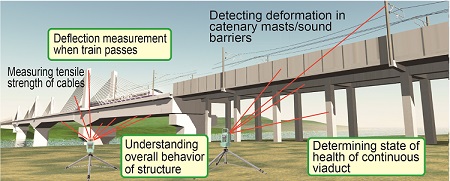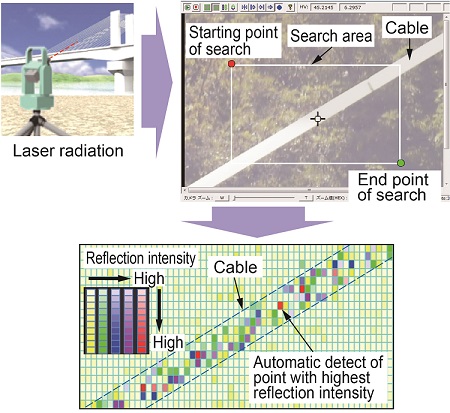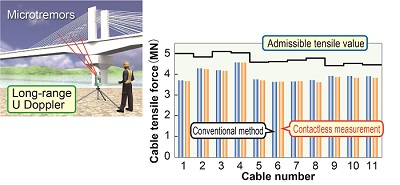10. Health monitoring of very large structures using long-range U-Doppler
A “long-range U-Doppler” has been developed (Fig. 1) which has made it possible to investigate changes in the behavior of railway bridges due to failing health, and even detect deformation in ancillary structures, without the need to access elevated positions.
The long-range U-Doppler, which is a laser Doppler vibrometer installed on a custom-built horizontally and vertically adjustable rotating base permits long-range remote stable measurements, has extended the conventional remote measuring distance from 30 to 300m, even when the target structure does not have a reflecting plate.
The laser’s automatic scanning function allows it to identify the points on the target structure within the measurement zone that offer the highest reflection intensity (Fig. 2). This algorithm now makes it possible to efficiently make measurements from large distances and of structures that were difficult to measure until now, for example, measurements that have to be made from far away, of cables with curved surfaces or structures with dirty surfaces.
For example, measurement of the tensile force of 44 cables on a cable stayed bridge with a span of about 130m, would require four night shifts using the conventional method, whereas the present contactless method can achieve the same result with equal accuracy in just one hour during the day time (Fig. 3).
In addition, an algorithm was created to enable measurement of individual vibration components of viaducts with complex 3-D vibrations, using simultaneous measurements from two Long-range U-Doppler devices.
This has made it possible to measure the natural frequency of each span on the viaduct remotely, in a single visit from a single spot.
Other Contents
- 1. Earthquake damage simulator for railways with self-correcting function
- 2. Practical application of early earthquake warning method using ocean bottom seismometer data
- 3. Countermeasures to prevent subsidence of abutment backfill and track buckling during earthquakes
- 4. Ground surface layer response evaluation method for very large earthquakes
- 5. Anti-seismic reinforcement method for suspended-ceilings with small cavities at stations
- 6. Algorithm to estimate strong wind locations due to such as gusts.
- 7. Flowchart to determine possibility of reusing bridge following scouring damage
- 8. Increase in accuracy of bogie hunting stability evaluation
- 9. Driver visual recognition support method using image processing
- 10. Health monitoring of very large structures using long-range U-Doppler
- 11. Influence of pinion shaft bearing endplay (axial clearance) on its seizure initiation
- 1. Earthquake damage simulator for railways with self-correcting function
- 2. Practical application of early earthquake warning method using ocean bottom seismometer data
- 3. Countermeasures to prevent subsidence of abutment backfill and track buckling during earthquakes
- 4. Ground surface layer response evaluation method for very large earthquakes
- 5. Anti-seismic reinforcement method for suspended-ceilings with small cavities at stations
- 6. Algorithm to estimate strong wind locations due to such as gusts.
- 7. Flowchart to determine possibility of reusing bridge following scouring damage
- 8. Increase in accuracy of bogie hunting stability evaluation
- 9. Driver visual recognition support method using image processing
- 10. Health monitoring of very large structures using long-range U-Doppler
- 11. Influence of pinion shaft bearing endplay (axial clearance) on its seizure initiation



